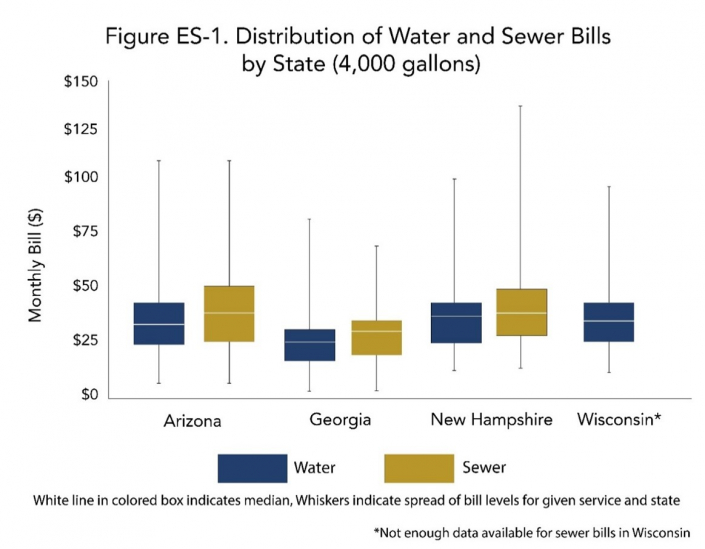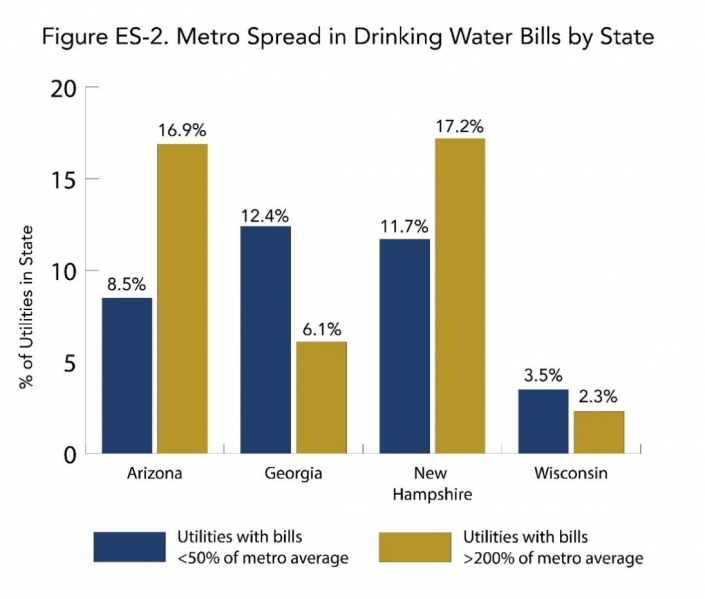Commonalities, Correlates and Variation in Household Water and Sewer Bill Levels in 4 U.S. States
New 4-state study of drinking water and sewer service bill levels finds remarkably similar state averages but varying local expenditure burdens.

By Grace Harrison
Over the past decade, rising bills for residential drinking water and sewer service across the U.S. have raised concerns about households’ ability to afford these essential services. The COVID-19 pandemic has highlighted water access as a public health concern and laid bare many of the stark economic inequalities related to accessing water-related services. Understanding factors that contribute to variation in water and sewer system bill levels is valuable to inform policies to improve household water affordability.
A new Natural Resources Defense Council-funded study led by Human Right to Water Solutions Lab director Greg Pierce, Lab Collaborator Ahmed Rachid (A.R.) El-Khattabi and Luskin Center affiliated doctoral scholar Kyra Gmoser-Daskalakis contributes to our understanding of local-level bill variation which can inform regulators, policy makers and advocates efforts to address water system technical, managerial and financial (TMF) capacity, population economic capacity and customer affordability at scale, as well as inform water system “Needs Assessment” efforts.
The study examines residential household water and sewer bill levels in 1,720 systems across four states (Arizona, Georgia, New Hampshire and Wisconsin) to better understand 1) differences in bill levels, both across and within states, and 2) the relationship between bill levels and system-level characteristics. This study is unique in examining how bill levels for drinking water, and secondarily sewer service, vary within and across states, and by sub-state region, defined as combined metropolitan statistical areas (MSAs). Comparisons at different geographic scales allow us to look for potential similarities in regulatory environment, climate, water source availability, and other factors that influence bill levels. Using these data, the authors describe both water and sewer bill levels across and within the four states, and then employ a multivariate regression analysis to examine system-level drivers of water bill levels.
The authors find remarkable similarity in median water and sewer bill levels across states. At the same time, they find significant variation in the distribution of bill levels within states and even within MSAs. Water bill levels have historically been and largely remain a local matter with some state oversight. Significant variation in bill levels may be justifiable, and the identified correlates of high bills vary in terms of the ability for external policy and planning influence.


Understanding variation in water bill levels is important in the context of affordability and environmental justice efforts. Notably, substantial disparities in water bill levels motivate consideration of policy options for systems with extreme bill levels, including (but not limited to) increased and equitably allocated federal and state water infrastructure funding, assistance to promote systems’ TMF capacity, potential consolidation, customer assistance and affordability programs, and equitable rate design guidance.
Growing recognition by regulators, policy makers and advocates of the financial obstacles to safe, reliable water access centers around three interrelated factors— 1) a water system’s TMF capacity, 2) the service population’s economic condition, and 3) customer level affordability. More importantly, there is also recognition that the results of these analyses need to be incorporated in water system needs assessment efforts.
Some of the variation in water bill levels seen across systems in this study can be explained by system ownership type, size, water source, rate structure, the bill levels of neighbors, race-ethnicity, income inequality of customers, and other characteristics. On the one hand, having neighboring systems with higher bills and using purchased water as the main water source are both strongly associated with having higher bill levels. On the other hand, municipal ownership type, larger service population, and a baseline monthly allowance of water are all associated with having lower bills, supporting hypotheses from existing studies. Increased income inequality and higher proportions of Non-White customers are also associated with having lower bills for systems, counter to the authors’ expectations, but these factors had relatively low explanatory power. Further exploration into the two-way relationship between a system’s customer demographics (beyond median household income) and water bill levels is essential.
Thus, while the study’s findings have implications for state and national water assessment efforts, the extent to which these results are generalizable across the U.S. is unclear. Collecting and analyzing bill data from more states will be essential to assess the generalizability of these results. Notwithstanding, this study fills a gap in the literature that compares bill levels across and within states and examines the factors that drive variation in water bill levels across state boundaries. As such, the findings of this study provide insight for further water system TMF and affordability policies and identify future research and data collection needs to make those efforts more robust.


